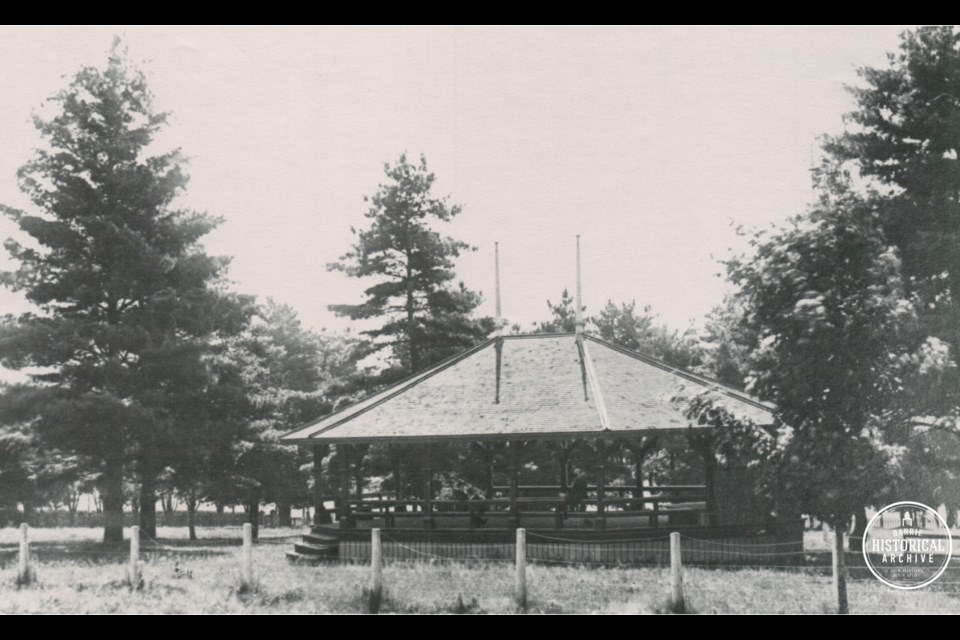This ongoing series from Barrie Historical Archive curator Deb Exel shows old photos from the collection and one from the present day.
St. Vincent Park
St. Vincent Street begins at Blake Street and runs all the way into Midhurst. The street was named for British Admiral John Jervis, Earl of St. Vincent, who was born in Staffordshire, England in 1735, and had many commands and naval accomplishments throughout his career.
St. Vincent Park is at the foot of St. Vincent Street, overlooking the bay.
In the earliest of days, there was an Aboriginal encampment in the St. Vincent Park area and longtime residents — who may be long gone by now — recall buying Native baskets and other items here at one time.
In the late 1800s, there were three main parks in Barrie: Queen’s Park, the Agricultural Park (the fairgrounds area bounded by Elizabeth, Bradford and Eccles streets) and St. Vincent Park, which was to have a station for Barrie’s streetcar system, planned in the late 1890s.
Parks at that time did not enjoy standardized services or support – they were each dependent on volunteer groups or council members for funding, until the Parks Commission was established in 1911.
In the July 21, 1921, edition of the Northern Advance, Mayor Little spoke of the plans for public bathing houses on the bay in Barrie.
“There will be built at the subway in front of St. Vincent’s Park. It is not advisable to have bathing houses erected at the head of the bay on account of the sewer situation, and those who bath where the sewer empties are taking great risk of contracting fever," Little said.
Barrie’s parks were considered tourist destinations, attractions or a good place to stop for a picnic when driving through town. Traffic was just as bad back in the day as it can be today – travellers on Highway 11 still had to take Burton Avenue, Bradford, Elizabeth, Dunlop and Blake streets around the bay through town to continue north on the highway.
Besides looking for a place to pull over for a rest stop, folks were also casting around for a place to spend the night as they passed through Barrie.
In the early 1920s, Benjamin Smith let people put up tents in the front yard of his home at the northeast corner of Blake and Rodney streets. This ‘campground’ was further improved when the Barrie Kiwanis Club built washrooms across Rodney Street on empty school grounds. The washrooms were moved to the Smith property after a neighbour complained.
The Smiths continued to develop their little ‘cottage’ industry, selling refreshments and eventually building log cabins that would become the Lake Simcoe Motel.
Other lodgings appeared in the neighbourhood by the end of the 1920s: the Homestead Inn at 81 Blake St., and Lakeside Cabins at 89 Blake St., both just east of St. Vincent Park.
St. Vincent Park continued to be a popular summer gathering place for families and events. In 1946, a speedboat regatta was held off the park on the August holiday weekend and in 1948, St. Vincent’s Park was one of seven supervised playgrounds in Barrie.
But for many people, what may have really put St. Vincent Park on the map was another summer event. In 1953, when the town of Barrie turned 100 year old, nine days of celebration kicked off on Aug. 1. On the Civic Holiday Monday, the Rotary Club sponsored the first community barbecue at St. Vincent Park, serving more than 500 people a half chicken dinner for $1.50 each. The Rotary Chicken BBQ was a popular summer tradition on the Civic Holiday weekend that continued for many years.
St. Vincent Park is still a lovely, shady east-end destination along Barrie’s peaceful north shore.



